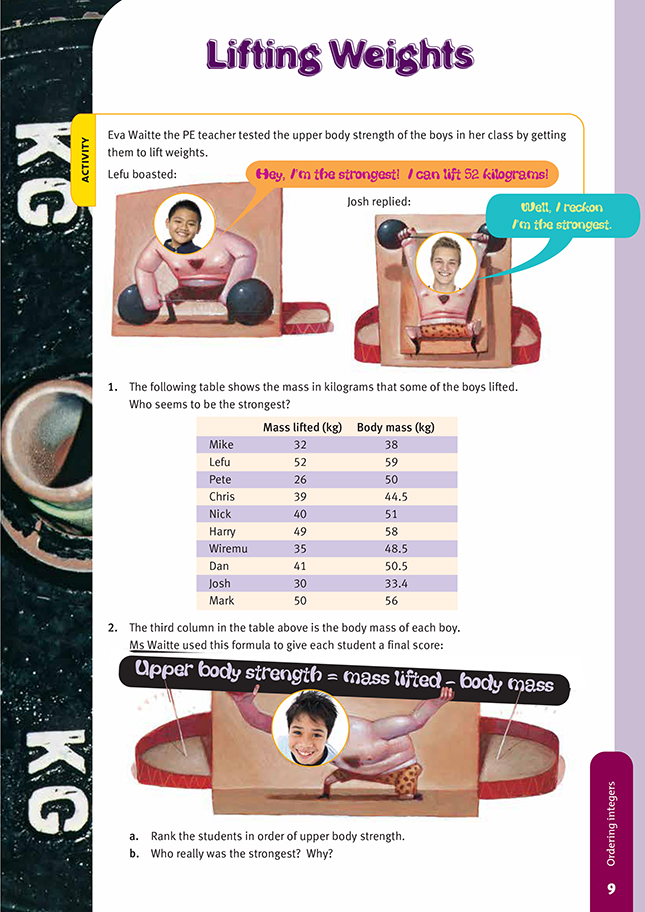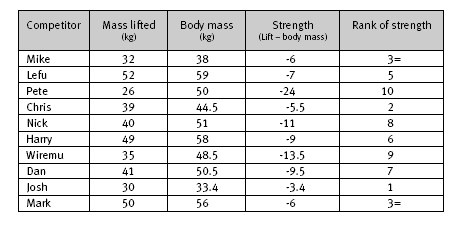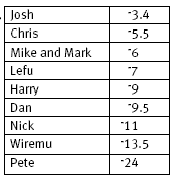This is a level 4 number link activity from the Figure It Out series. It relates to Stage 7 of the Number Framework.
A PDF of the student activity is included.
Click on the image to enlarge it. Click again to close. Download PDF (227 KB)
add and subtract integers
FIO, Link, Number, Book Four, Lifting Weights, page 9
This activity gives the students valuable practice in ordering negative numbers. They will need to subtract two-digit whole and one-place decimal numbers, resulting in an answer that is a negative number.
Question 1 lends itself to discussion. Some students may see the mass lifted as the best gauge of strength, whereas others may realise that assessing strength in terms of body mass and mass lifted has its own merit. This question links up with question 2b.
In question 2a, the students need to use the formula given. They could discuss the likely outcome of subtracting 38 from 32 as being six places to the left of zero on a number line before checking their ideas on a calculator, that is, 32 – 38 = -6. (The negative sign may be located on the left-hand side of the calculator display.)
Some initial discussion about ordering negative numbers may also be valuable. Part of this can involve:
• placing different-coloured counters or a peg on a blank number line for given negative numbers and ordering the different colours;
• having a variety of negative numbers printed in large letters on individual pieces of A4 card or paper and asking students to select one of the numbers and line up in the correct sequence at the front of the classroom (the rest of the class can assist with the process);
• small groups doing the two activities listed above but with smaller sets of numbered cards.
Have the students copy and complete the table in question 1, but get them to add a fourth column for the “mass lifted minus body mass” figures. Check that the students realise that if they subtract the mass lifted from the body mass (for example, 38 – 32), they need to show the lift as a negative number (in this case, -6). They could add a further column to rank the boys numerically according to strength.
Note that there are two boys with an equal third ranking, so the rank order for the next boy after that jumps to fifth.
The students could work in groups and record the results for the strength column on a large sheet of paper to share with the class later. They could also show the results visually by making a bar graph of the final scores of the boys’ strength.
An extension for Question 2 is to plot points for the mass lifted against body mass on a scatter plot, labelling each point with the rank order for upper body strength and noting the relationship to the diagonal line (which indicates the median) drawn through the middle. Some students may also be keen to investigate this formula, using data derived from an international sports event, such as the Olympic or Commonwealth Games.
For further interest, some students may also enjoy the challenge of expressing strength as a percentage, writing the mass data as a fraction: , and using the calculator to determine the result.
For Mike, this is , which is 84% (rounded). You could ask: “Does this produce the same ranking? Does it help to separate Mike and Mark?” (It does. Mike ends up with 84% strength and Mark with 89%.)
Answers to Activities
1. Answers may vary, but Lefu is probably the most likely answer because he lifts the heaviest mass.
2. a.
b. Josh. He can nearly lift the equivalent of his own body mass.


